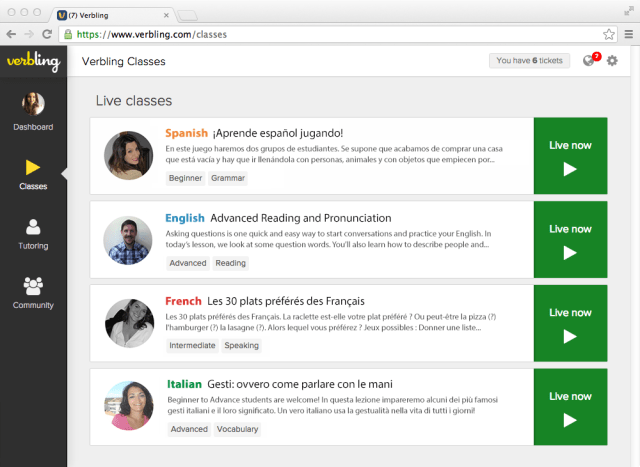Learning to speak a new language with any kind of fluency is a daunting task. Not only only does it require time, patience, and a great teacher but, ultimately, there’s no “right” way to go about it. Just as language learning tends to resist a one-size-fits-all approach, today the market offers a laundry list of services, apps and startups to choose from — each with its own approach to helping you become a polyglot.
To help it stand out from the pack and take on the Rosetta Stones of the world, Verbling has put a new, yet familiar spin on language learning. To help immerse students in a new language (and learn more effectively), Verbling uses frictionless, in-browser video chat to connect its learners with native speakers, live, in 3-D. What’s more, unlike many of its cohorts, the Y Combinator-backed education startup is focused on the Web, not mobile, and native apps, if they do come, are still a ways off.
From the outset, Verbling focused on building a network of native speakers in a few core languages so that it could instantly connect users with someone who’s fluent in the language they’re trying to learn. However, when we checked in with Verbling late last year, the company had begun to expand its scope — both by adding new languages and by moving beyond its original one-on-one video immersion model. The update saw Verbling add support for nine new languages and bring one-to-many, Google Hangouts-powered “classes” to its platform, with instruction led by an official, TEFL-certified Verbling teacher.
Today, Verbling Classes are group language lessons taught by trained teachers over live video chat in the browser. The startup limits class rosters to nine students per class, which allows it to keep class size manageable as well as offer language learning courses every hour, 24-hours a day, on-demand — with no advance reservation required. Since launching, Classes are now offered in a total of four languages and have quickly become the most popular feature on Verbling, says co-founder Jake Jolis.
Again, while Verbling’s focus on building a Web-sans-mobile product (at least for the time being) may make it seem behind the times, it allows it to offer on-demand, around-the-clock service no matter what time zone students are connecting from. While remaining hyper-focused can also be limiting, Jolis says that this always-on availability has come to be one of its most appealing features and a point of differentiation in a crowded space.
“It’s not uncommon to find people from 10 different countries in one single Verbling class,” he says, and this language-focused, cross-cultural experience can be a powerful tool not only for learning and engagement. After all, students can participate in these classes from the comfort of their living room couch.
Building on the success of its live classes, Verbling has continued to round out its language learning platform. This started with the addition of “Verbling Groups,” a free feature which allows anybody to start or join a Group video chat with up to 10 participants sharing the same target language. And, today, the startup is taking the next logical step with the addition of a new tutoring service.
Verbling’s new tutoring platform will enable language students anywhere to easily book live, hour-long private tutoring sessions with their teacher of choice. The new service is designed to have a premium feel and is aimed at the most dedicated students, Jolis says, while simultaneously allowing Verbling teachers to leverage their following and increase their income.
Whereas class prices are fixed at $3 for one class, 10 classes for $19/month and unlimited classes for $45/month, Verbling’s new tutoring platform allows teachers to set their own price and customers can pay (for it and all Verbling products) with a credit card or via PayPal. Tutoring will be available in the same four languages that Verbling Classes are offered in and will be available on-demand.
Beyond increasing the language learning options for its students and signaling its gradual expansion into a services platform, Verbling Tutoring also represents another potentially key revenue channel. Though the startup remains a lean operation and is still just five full-time employees three years in, if Classes are any indication, the team has reason for optimism.
Even though students can now watch classes without registering (or paying), students are still willing to pay for unlimited access, which Jolis tells us has become the startup’s most popular pricing plan. (And it also happens to be the most expensive.)
For this reason, Verbling has been able to maintain double-digit month-over-month revenue growth since it began accepting payments for classes eight months ago. Monthly revenues now stand in the “five figure range and growing,” Jolis adds, and Verbling’s monthly active users are now at over “six figures.” All in all, while that means Verbling is still relatively small compared to some others of its ilk, things definitely seem to be moving in the right direction.
As a result of its recent revenue growth, Verbling has also been able to raise an additional round of seed capital from Sam Altman and Hydrazine Capital, with contributions from Learn Capital, FundersClub, Rothenberg Ventures and Kevin Moore.
This follows the $20K Verbling received when it graduated from Y Combinator in 2011 and the $1 million in seed funding it raised in the months following from DFJ, Learn Capital, SV Angel, Start Fund, Ace & Company, Meck Investments and Inspovation, among others.
For those who’d like to get access to a one-week free trial and $20 off the first month for the $54 million Verbling Serious Learner, Unlimited Classes, use the “TECHCRUNCH” code at checkout.


